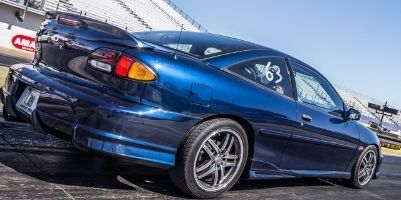Why use DCR??? Or SCR? Is ECR a real term?
The three basics forming the "why" of CR.
Power output is directly related to the amount of fuel and air reacted in the cylinder. Higher cylinder pressure at the right time means more work can be done by the piston. The hotrodder's goal is maximum fuel and air charge into the cylinder under the highest pressure prior to combustion.
For a given fuel of a specific octane rating there is a temperature which, when reached, causes the fuel to begin reacting without any spark input. Once this temperature is passed, the reaction continues violently and extremely quickly. Detonation, loss of power, possible engine damage are the result.
Temperature within a cylinder is directly related to the pressure inside that cylinder. Excess pressure causes excess temperature.
Now here's the "why."
You're a good little hotrodder and you're wanting to run the balance between maximum fuel and air charge under maximum pressure without exceeding autoignition temp. How to do it? Easy if you have an "in cylinder temperature gauge," right? Yeah, ok. Most of us will never see equipment able to do that job. Ahhh... but you know cylinder pressure is related to temperature. So you think "maybe I can figure out how much pressure is created by figuring out how much air is compressed in the cylinder." That shouldn't be too hard. The math isn't a big deal. You determine the volume of the closed cylinder including the volume of the combustion chamber, the volume of the head gasket when compressed, and the volume from the deck or top of the cylinder block down to the top of the first ring. Now all you need to do is compare the volumes with the piston at the bottom of the stroke and with the piston at the top of the stroke, and you can begin to calculate how much air is compressed by the piston as it sweeps from BDC to TDC. You tell your friends, they like the idea, they tell their friends, and eventually everyone is happy that they have a way to figure out how much compression is enough to kill an engine through detonation. And because they're good little hotrodders too, they constantly work to exceed what everyone else knows is safe. Welcome, Static Compression Ratio.
But you're realizing you may not have gotten it exactly right. First of all, the heat and pressure calculations using SCR are showing that somewhere between 8.0:1 and 9.0:1 should produce enough heat to cause loads of detonation. But that loudmouth punk on JBO is running 10.5:1 and getting away with it. Worse yet, he doesn't know Jack Schitt, so you know he's not some kind of super genius from the School for the Gifted. He must have gotten lucky, somehow. Finally a little voice says "umm... the cylinder isn't really compressing as much air as you think. It's only partially filled during the compression stroke, so the pressure and temperature are lower than the SCR leads you to believe." You begin to think about it and decide that the measurements for calculating compression, and the method, were completely right. But you need some way to estimate the amount of air which actually enters the cylinder to be compressed. After more thought you realize it's easy! Since the intake stroke is what determines how much air gets into the cylinder, and since the intake valve has to close before compression can begin, all you need to do is figure out where in the cylinder the piston is when the valve closes, and use that value for your new BDC measurement. To do this you've got to work out crank pin position and it's relationship to the piston position, and adjust those for the crank angle when the intake valve closes. When you finally get it you tell all your friends, and they tell all their friends, and eventually most of 'em say "that's too damn much math" and they stick with SCR. Oh, well. But a few of them get the concept that valve timing is a big deal in determining pressure at TDC, and eventually there's a whole lot of people running larger SCR numbers and using big cams to bleed of cylinder pressure at low rpm. At least the loudmouth punk finally got his a$$ kicked. Thank you Dynamic Compression Ratio
But something's still a little funny. You know that the compression stroke doesn't really begin until the intake valve closes. But you're trying to figure out how much pressure is created in the cylinder, and pressure depends on the amount of air in the cylinder. It's pretty obvious that a closed throttle won't let much air in, and there can't be much pressure created in that situation. The real kicker is that the loudmouth punk on JBO built a new engine running 12.5:1 with a mild cam and the engine hasn't blown up yet. "Obviously," you say, "his engine is also as dumb as a stump and can't see that the DCR is way too high for it to do what it's doing." Wouldn't it be nice if you could prove that this kid got lucky, again? The trick, you realize, is to do a better job of estimating the amount of air in the cylinder during the compression stroke. If you can apply a percentage factor, some way to scale DCR up or down for conditions with less or more air, then you would have a great comparison tool. You could even go over to the Honda board and tell them a thing or two about how your engine is really so different from theirs. So you think, and think, and think again. Maybe you even ask for a little help with this one. Now you're getting into air density and it's relationship to air temp, and you're working with moisture content and the mass of fuel. You're considering air velocity and the effects of compressing the air before it enters the cylinder. Heck, you're even considering temperature differences between the intake manifold and the head of the intake valve. And after all of these dizzying factors, after using MS Excel, hundreds of calculator batteries, countless sheets of paper, and even learning to use a version of Matlab you found on a warez site, you have one of those head slapping moments when it dawns on you that all you've done is calculate engine Volumetric Efficiency. Doh! So you tell your friends that they need to scale DCR with engine VE and then they can effectively calculate in cylinder pre-combustion temp so the fuel they're using never detonates. They tell their friends. Eventually everyone comes to the conclusion that you're not completely normal but you definitely seem to know Jack Schitt. Meanwhile the punk on JBO tries to prove you're a cousin to Dip Schitt by replacing his stock intake system and 2" exhaust with a 1000 CFM intake and open header, and he promptly blows the thing apart due to detonation. Ahhh, yes. Now that's what Effective Compression Ratio is all about.
Back to reality.
This is a really simplified presentation. The idea is that you can look at the articles referenced by the original poster above with some type of overview as to what they're doing and why.
The main reason to work with SCR when you don't have powerful analysis tools is to determine cylinder configuration. For example, trying to build a 3" bore, 3" stroke engine with 10:1 SCR using a 76CC combustion chamber and flat top pistons is an excercise in futility. It's not a practical engine and being able to work out the numbers may save you from wasting time and money on parts you can't use.
The main reason to work with DCR is to predict the fuel compatibility of the engine and to attempt to balance losses due to lowered VE.
ECR has different definitions in different articles. ECR is often interchanged with DCR. Because ECR as I've described it uses VE as a correction factor, I have always used ECR as a comparison tool, like using "corrected" horsepower to compare different engines. I may be using the wrong term for what I'm calculating, but the results it provides are useful nonetheless.
In all cases thermal efficiency is improved by increased compression ratios to the limit of detonation. Emissions considerations, however, often require lower than optimum compression ratios.
These articles are also very good. Any
David Vizard article is worth a read.
This one is much more in depth. This guy not only builds engine, but he has a superb understanding of why they work. Here's a
simple description of DCR, and
this article analyzes the method used in the DCR calculator from the previous article. This last one has plenty of math for burning up calculator batteries. Digest these articles in small bites with plenty of time to chew on what's presented. They do a good job of touching on "everything that an engine is about."
As a final note, I'd like to say while engines are math, there are plenty of guys that do a damn good jop of building a nice engine without knowing what to calculate to do it. Don't knock 'em for what they don't know since they may have spent years with trial and error methods. This type of learning can be invaluable! Use the math to understand why the engines they build are working without having to spend your life re-learnign the lessons they've learned.
-->Slow
















